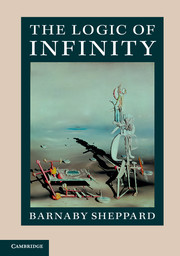Book contents
- Frontmatter
- Contents
- Preface
- Synopsis
- 1 Introduction
- 2 Logical foundations
- 3 Avoiding Russell's paradox
- 4 Further axioms
- 5 Relations and order
- 6 Ordinal numbers and the Axiom of Infinity
- 7 Infinite arithmetic
- 8 Cardinal numbers
- 9 The Axiom of Choice and the Continuum Hypothesis
- 10 Models
- 11 From Gödel to Cohen
- A Peano Arithmetic
- B Zermelo–Fraenkel set theory
- C Gödel's Incompleteness Theorems
- Bibliography
- Index
6 - Ordinal numbers and the Axiom of Infinity
Published online by Cambridge University Press: 05 August 2014
- Frontmatter
- Contents
- Preface
- Synopsis
- 1 Introduction
- 2 Logical foundations
- 3 Avoiding Russell's paradox
- 4 Further axioms
- 5 Relations and order
- 6 Ordinal numbers and the Axiom of Infinity
- 7 Infinite arithmetic
- 8 Cardinal numbers
- 9 The Axiom of Choice and the Continuum Hypothesis
- 10 Models
- 11 From Gödel to Cohen
- A Peano Arithmetic
- B Zermelo–Fraenkel set theory
- C Gödel's Incompleteness Theorems
- Bibliography
- Index
Summary
Ordinal numbers
Guided only by their feeling for symmetry, simplicity, and generality, and an indefinable sense of the fitness of things, creative mathematicians now, as in the past, are inspired by the art of mathematics rather than by any prospect of ultimate usefulness.
–Eric Temple BellThe emergence of ordinality
Cantor described an ordinal number, where M is an arbitrary well-ordered set, as ‘the general concept which results from M if we abstract from the nature of its elements while retaining their order of precedence…’. Making this precise, the classical view of ordinal numbers begins by defining the notion of an order type – the set of all ordered sets which are order isomorphic to some fixed ordered set – and then isolates the ordinal numbers as the collection of all order types of well-ordered sets.
This approach is intuitively pleasing to a certain degree, yet one might object to something as ‘simple’ as 1 being modelled by the class of all single element sets, which is, after all, a proper class. Some would provocatively adopt an extremist position, arguing that the apparent simplicity we perceive in the Platonic idea of ordinal numbers is an illusion; an unfortunate result of brainwashing in infancy. From a constructivist point of view the most immediate objection to the classical definition of ordinal numbers is that the entire set theoretical universe must be defined before we can extract any ordinals from it.
- Type
- Chapter
- Information
- The Logic of Infinity , pp. 283 - 302Publisher: Cambridge University PressPrint publication year: 2014



